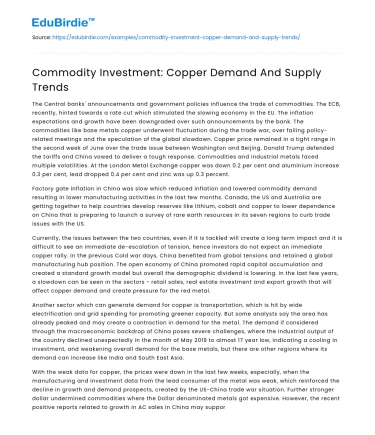The Central banks' announcements and government policies influence the trade of commodities. The ECB, recently, hinted towards a rate cut which stimulated the slowing economy in the EU. The inflation expectations and growth have been downgraded over such announcements by the bank. The commodities like base metals copper underwent fluctuation during the trade war, over failing policy-related meetings and the speculation of the global slowdown. Copper price remained in a tight range in the second week of June over the trade issue between Washington and Beijing. Donald Trump defended the tariffs and China vowed to deliver a tough response. Commodities and industrial metals faced multiple volatilities. At the London Metal Exchange copper was down 0.2 per cent and aluminium increase 0.3 per cent, lead dropped 0.4 per cent and zinc was up 0.3 percent.
Factory gate inflation in China was slow which reduced inflation and lowered commodity demand resulting in lower manufacturing activities in the last few months. Canada, the US and Australia are getting together to help countries develop reserves like lithium, cobalt and copper to lower dependence on China that is preparing to launch a survey of rare earth resources in its seven regions to curb trade issues with the US.
Save your time!
We can take care of your essay
- Proper editing and formatting
- Free revision, title page, and bibliography
- Flexible prices and money-back guarantee
Currently, the issues between the two countries, even if it is tackled will create a long term impact and it is difficult to see an immediate de-escalation of tension, hence investors do not expect an immediate copper rally. In the previous Cold war days, China benefited from global tensions and retained a global manufacturing hub position. The open economy of China promoted rapid capital accumulation and created a standard growth model but overall the demographic dividend is lowering. In the last few years, a slowdown can be seen in the sectors - retail sales, real estate investment and export growth that will affect copper demand and create pressure for the red metal.
Another sector which can generate demand for copper is transportation, which is hit by wide electrification and grid spending for promoting greener capacity. But some analysts say the area has already peaked and may create a contraction in demand for the metal. The demand if considered through the macroeconomic backdrop of China poses severe challenges, where the industrial output of the country declined unexpectedly in the month of May 2019 to almost 17 year low, indicating a cooling in investment, and weakening overall demand for the base metals, but there are other regions where its demand can increase like India and South East Asia.
With the weak data for copper, the prices were down in the last few weeks, especially, when the manufacturing and investment data from the lead consumer of the metal was weak, which reinforced the decline in growth and demand prospects, created by the US-China trade war situation. Further stronger dollar undermined commodities where the Dollar denominated metals got expensive. However, the recent positive reports related to growth in AC sales in China may support prices and prevent a decline.






 Stuck on your essay?
Stuck on your essay?

